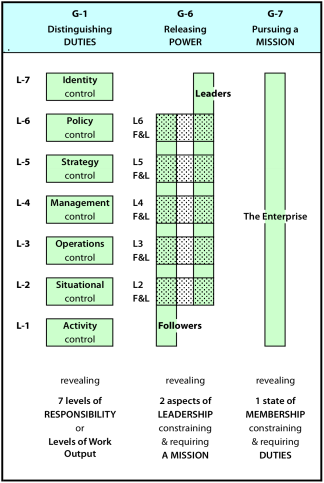False Positive 2: The Alchemist

The Janus-Honcho
To explain the Alchemist, THEE needs to propose a similarly vague Leadership category: the Janus-Honcho
This category should be easily recognizable: it refers to a leader who is a superior and has a team whose members regard themselves as subordinate. Unlike R&T's power-centred Opportunist who uses people exploitatively, the Janus-Honcho strives more or less to use people constructively—for their own good and to ensure his own targets are met.
 Typical Janus-Honcho Features
Typical Janus-Honcho Features
● feels responsible for results and checks progress often
● likes to choose his own team members
● makes team members aware of their subordinate status
● issues instructions and determines priorities
● focuses on the calibre of each subordinate
● ensures responsibilities and tasks suit individual subordinates
● feels entitled to zoom into what any subordinate is doing at any time
● considers training needs and development potential of each subordinate
● sets other contexts like standards and policies
● gets preoccupied by workloads, costs, efficiency, quality standards
● spends time negotiating with other similar Janus-Honchos
+
● sees himself as a subordinate of a higher Janus-Honcho
 Q: Is this a category of leader?
Q: Is this a category of leader?
You can decide for yourself, but the subordinates have already decided. They know they must follow their superior, good or bad, with or without clear goals, like it or lump it. They see their superior as "the boss". The formal label is usually: manager or line manager or main line manager. In every case, each of these leaders is also an unambiguous subordinate-follower of a higher superior.
 More on Management Levels
More on Management Levels
Up to now, there has been no focus on followers, but look at the Levels of Work-responsibility diagram below. This shows the 7 hierarchical levels that THEE identifies in large organizations. It allows for numerous distinct Janus-Honchos. There are at least five levels of Leader who are also Followers; and it is also possible to have teams with leaders in Level 1.
The difference in work capacity and output expected when moving from level to the next (as defined by THEE) is significant: ●social relations change, ●weight of responsibility jumps, ●relevant realities shift markedly, ●scope and time-scale of tasks increase substantially.
 Is «Janus-Honcho» a good label?
Is «Janus-Honcho» a good label?
You must judge: it was chosen to be as puzzling as Alchemist. The name is based on these leader-superiors who are simultaneously subordinate-followers. Like the Greek God, Janus who is depicted with two faces on opposite sides of his head, they must simultaneously face both ways at all times: up the hierarchy and down the hierarchy. Such leaders should not be found in corporate HQs, although they probably are.
THEE's Bottom Line: To lump together leaders responsible for strategy (L5) or international expansion (L6) with someone who organizes catering services (L3) or leads the returned goods section (L2) would be confusing in the extreme. This is precisely the confusion arising with R&T's Alchemist.
THEE Analysis of R&T's Alchemists
Alchemists are people with extraordinarily high abilities.They are evidently able to operate on society, rather than just within it (i.e. where the top Janus-Honchos reside). R&T use Nelson Mandela as their example!  Just look at R&T's list of Alchemist personal qualities ►
Just look at R&T's list of Alchemist personal qualities ►

● dealing simultaneously with many situations at multiple levels
● talking with both kings and commoners
● handling immediate priorities yet never lose sight of long-term goals
● engaging with multiple organizations on a daily basis
● dealing with issues without being in a constant rush
PLUS
● extremely aware
● living by high moral standards
● focusing intensely on the truth
● creating symbols and metaphors that speak to people's hearts and minds
Alchemists are spread out over many of THEE's levels of work, with each of these levels capable of defining a mentality or approach (i.e. a leadership category). This is exactly the same as Janus-Honchos, just in a higher domain.
 Using Language at Work
Using Language at Work
Personal capacity in work is dependent on how a person makes sense of the world and how he or she expresses that sense to others i.e. work capability is a function of the use of language.
THEE identifies different ways of using language that lead to 7 societal domains of work. The diagram shows some of these. In all, the framework has 28 levels identifying distinctive capacities to appreciate and communicate about the world so as to alter it i.e. to work.
In the typical organization, language is used in an associative way, much as in everyday life among friends—which is sufficient for producing tangible goods and services. It is not enough for new economy businesses, where conceptual language is required. Operating on society requires a different use of language yet again, named in THEE: universal. And so on.
We have now covered all the categories identified by R&T, clarified their nature, and identified additional categories whose absence from the list is, to say the least, puzzling.
- Before the Report Card is issued, review the 7 transformations promised by R&T's title.
Last Updated: 12-Jan-2012

![]() Q: Is this a category of leader?
Q: Is this a category of leader? ![]() Is «Janus-Honcho» a good label?
Is «Janus-Honcho» a good label?
![]() Just look at R&T's list of Alchemist personal qualities ►
Just look at R&T's list of Alchemist personal qualities ►